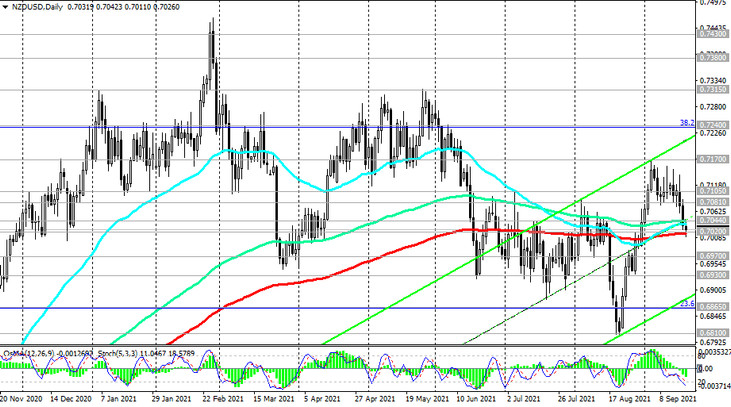Futures for major US and global stock indexes are declining again in the first half of today's trading day.
Moreover, this decline, first outlined in early September, is gaining momentum. Investors are waiting for the results of the Fed meeting, which will end on Wednesday with the publication of the rate decision. Market participants do not expect central bank executives to begin phasing out stimulus policy, under which they keep the key rate at 0.25% by purchasing at least $ 120 billion in government bonds and mortgage bonds every month. The main expectations boil down to the fact that the leaders of the FRS can announce the possibility of starting the curtailment of the QE program this year. Many economists believe that the Fed may begin this process after the November meeting.
These expectations are underpinned by relatively high inflation and a gradual improvement in the labor market, while the US has recently been receiving positive macro data indicating an ongoing economic recovery.
Thus, the data on retail sales in the United States published last week showed an increase in the indicator by +0.7% in August (against the forecast of -0.8% and a fall of -1.1% in July). Retail sales of the control group of goods showed an increase in August by +2.5%. The weekly report of the US Department of Labor published last Thursday was also generally positive. Although the number of initial applications for unemployment benefits in the United States increased and amounted to 332 thousand compared to 312 thousand a week earlier, the total number of people receiving benefits dropped to 2.665 million from 2.852 million a week earlier, and the average number of initial claims for the past 4 weeks on September 10 decreased from 340 thousand to 335.75 thousand
The June forecasts of the FRS showed an increase in the propensity of executives to raise interest rates. Earlier, the median forecast of the Fed leaders assumed that there will be no key rate hikes in the current and next year, and in 2023 it will be raised twice. At the same time, almost half of the executives (7 out of 18) admitted a rate hike the next year.
The prospect of a reduction in the QE program is once again becoming one of the main drivers of the dollar's growth, which is actively strengthening at the beginning of the week. So, futures on the DXY dollar index at the beginning of today's European trading session are near the mark of 93.40, 23 points higher than the closing price last Friday, rising again towards the local 9-month high of 93.75, reached in August.
Meanwhile, investors remain worried about the rapidly spreading strain of the delta coronavirus, which, along with a re-escalation of tensions between China on the one hand, and the United States and other Western countries, on the other, is increasing stock market caution and demand for the dollar as on a protective asset. Probably, before the publication of the decision on the FRS rates on Wednesday, the US dollar may continue to strengthen. Then its dynamics will depend on the decision of the US Federal Reserve on the interest rate and the subsequent press conference.
Against the background of the strengthening of the dollar and expectations of the imminent start of curtailing the Fed's QE program, commodity prices are decreasing, which leads, accordingly, to a fall in the quotes of commodity currencies.
Thus, the Canadian and Australian dollars today fell sharply against the USD. The fall of the NZD / USD pair is less pronounced, although this currency pair also remains under pressure, but is still in the bull market zone, above the key support levels 0.7020, 0.6970 (see "Technical analysis and trading recommendations").

Additional pressure on the NZD quotes today is exerted by the recently released weak macro statistics from New Zealand. Thus, the index of activity in the service sector (from the Business NZ agency) decreased in August from 57.9 to 35.6, and the PMI index of business activity in the country's manufacturing sector in August fell sharply from 62.6 to 40.1.
For today, the publication of important macro statistics in the economic calendar is not planned. Nonetheless, market participants following the NZD dynamics will pay attention to the publication in the evening of the Westpac quarterly report examining New Zealand consumer sentiment in the third quarter. Deteriorating consumer sentiment may also negatively affect the NZD quotes.
Tomorrow, in the period after 14:00 (GMT), the volatility in the NZD quotes may increase again, since the next report of the Global Dairy Trade on the dynamics of prices for dairy products will be published. A similar report released on September 7 indicated a 4.0% rise in the dairy price index, which supported the NZD. A significant portion of New Zealand's exports are dairy products, primarily milk powder. The decline in world prices for dairy products has a negative impact on the NZD, reducing the level of export foreign exchange earnings to the country's budget, while the growth in the indicator is a positive factor and will support the NZD (in the short term).
And on Thursday, market participants trading in the NZD will pay attention to the publication at 22:45 (GMT) of the latest data on the trade balance of New Zealand. In July, New Zealand's trade balance unexpectedly went over to the deficit side, although it had been in surplus in previous months.
Another growth in the deficit will have a negative impact on the NZD, although it will be short-term.
But once again we emphasize that the central event of this week will still be the Fed meeting, which starts tomorrow and ends on Wednesday with the publication (at 18:00 GMT) of the decision on the interest rate. The Fed's press conference will begin at 18:30. During this period of time, a surge in volatility is expected throughout the financial market, including in the NZD / USD pair.





